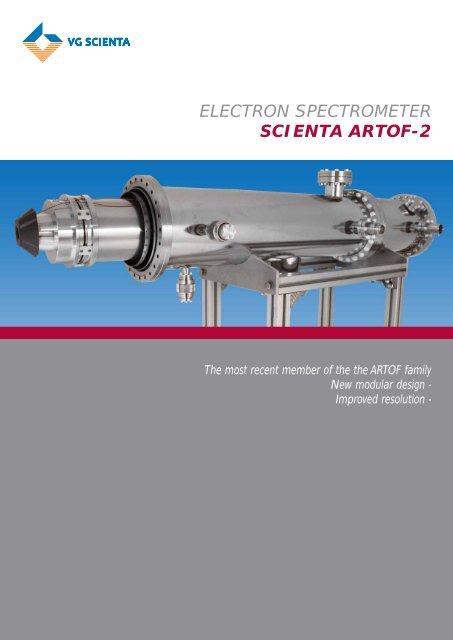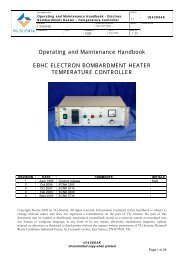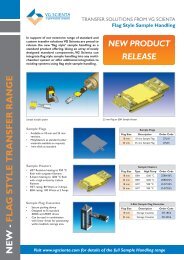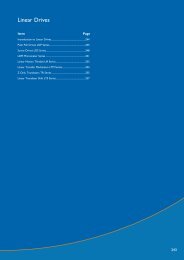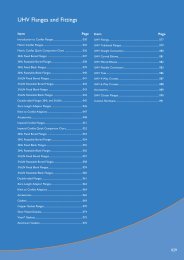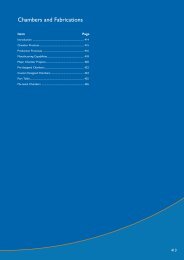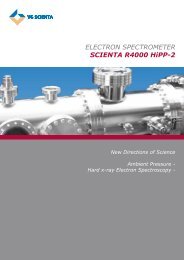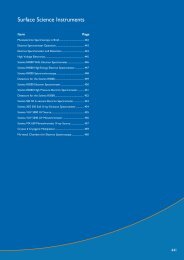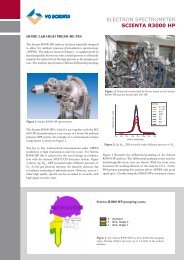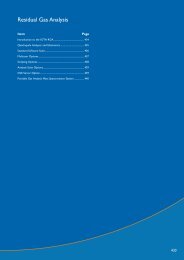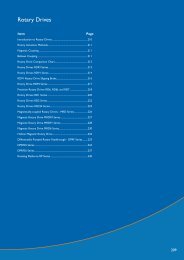ELECTRON SPECTROMETER SCIENTA ARTOF-2 - VG Scienta
ELECTRON SPECTROMETER SCIENTA ARTOF-2 - VG Scienta
ELECTRON SPECTROMETER SCIENTA ARTOF-2 - VG Scienta
Create successful ePaper yourself
Turn your PDF publications into a flip-book with our unique Google optimized e-Paper software.
<strong>ELECTRON</strong> <strong>SPECTROMETER</strong><br />
<strong>SCIENTA</strong> <strong>ARTOF</strong>-2<br />
The most recent member of the the <strong>ARTOF</strong> family<br />
New modular design -<br />
Improved resolution -
The <strong>Scienta</strong> <strong>ARTOF</strong> 10k analyser marked a revolution in the fi eld of angle-resolved photoelectron<br />
spectroscopy with its parallel full cone detection and unchallenged transmission. The <strong>Scienta</strong> <strong>ARTOF</strong>-2<br />
is a further development of the <strong>ARTOF</strong> concept featuring a number of important improvements,<br />
especially for kinetic energies above 10 eV.<br />
The <strong>Scienta</strong> <strong>ARTOF</strong> concept<br />
In contrast to traditional electron spectrometers the<br />
<strong>Scienta</strong> <strong>ARTOF</strong> analysers do not include entrance<br />
slits. Therefore, electrons are gathered in a complete<br />
cone, with energy and angle resolution. The maximum<br />
acceptance angle, with full detection, is ±15°. In this<br />
way two-dimensional band mapping experiments can<br />
be performed without sample rotation. Furthermore,<br />
the transmission is increased up to 250 times compared<br />
to traditional hemispherical electron analysers.<br />
The latest member of the <strong>ARTOF</strong> family<br />
The new <strong>Scienta</strong> <strong>ARTOF</strong>-2, shown in fi gure 1, is a<br />
development of the much acclaimed <strong>Scienta</strong> <strong>ARTOF</strong><br />
10k analyser, featuring a number of important<br />
improvements. Firstly, the analyser has a new and<br />
more advanced lens sysem optimized to reduce the<br />
number of electrons above the energy region of<br />
interest that reaches the detector, especially at higher<br />
kinetic energhies (>10 eV). The new lens design also<br />
enables larger energy windows with improved energy<br />
resolution. Secondly, the analyser is based on a new<br />
Figure 1. The new <strong>Scienta</strong> <strong>ARTOF</strong>-2 analyser, displaying the new<br />
lens front.<br />
Distance from lens axis (mm)<br />
20<br />
10<br />
0<br />
-10<br />
-20<br />
0.0 0.2 0.4 0.6 0.8 1.0 1.2<br />
The graph shows calculated trajectories for 2 eV electrons<br />
with lens voltages optimized for a 0.4 eV energy window<br />
around 2 eV, and with angular window ±15°. The separation<br />
between trajectory pencils is 2° and the source diameter<br />
was 0.25 mm.<br />
modular design that enables future upgrades of lens<br />
front and detector area. Thirdly, improved pumping<br />
capacity has been enables by the addition of two<br />
new pump ports (shown in fi gure 2) and an optional<br />
differential pumping modifi cation.<br />
Figure 2. The new design features two pump ports for increased<br />
pumping capacity.<br />
Angular and Alignment modes<br />
One important advantage of the <strong>Scienta</strong> <strong>ARTOF</strong><br />
analysers is the alignment mode that enables realtime<br />
alignment using the electron optics and detector.<br />
Once alignment is achieved, the <strong>ARTOF</strong>-2 can be<br />
operated in either of two angular resolving modes,<br />
with ±7° or ±15° range, for high-resolution ARPES<br />
measurements.<br />
Distance from axis (mm)<br />
<strong>Scienta</strong> <strong>ARTOF</strong>-2 improvements:<br />
• New lens for improved detection effi ciency<br />
• New modular design<br />
• Larger energy windows with improved<br />
resolution<br />
• Prepared for future upgrades of lens front and<br />
detector<br />
• Improved pumping possibilities<br />
2.2<br />
2.1<br />
14<br />
12<br />
10<br />
2 eV 1.9<br />
Distance from sample (mm) Flight time (ns)<br />
15<br />
10<br />
5<br />
0<br />
This plot shows how the measured time of fl ight and electron<br />
position on the detector is converted to energy and angular<br />
information for one particular lens setting. The energy contours<br />
are horizontal while the polar angle contours are vertical.<br />
8<br />
6<br />
4<br />
2<br />
1280 1300 1320 1340 1360<br />
1.8
Suitable photon sources and triggers<br />
The <strong>Scienta</strong> <strong>ARTOF</strong>-2 can handle all repetition rates<br />
between 0 and approximately 3.0 MHz. Even higher<br />
repetition rates can be used with special software<br />
treatment.<br />
The pulse length will infl uence the energy resolution.<br />
Long pulses decrease the accuracy in determining the<br />
time of fl ight. On the other hand, very short pulses<br />
are less well defi ned in energy, due to the transform<br />
limitation. The optimum pulse length, depending on<br />
resolution requirements, ranges from tens of femtoseconds<br />
to hundreds of picoseconds. Smaller spot<br />
size increases the resolution in both energy and angle.<br />
The <strong>Scienta</strong> <strong>ARTOF</strong>-2 is built to be triggered by the<br />
laser or beamline bunches that defi ne time zero for<br />
the time of fl ight measurements. Any trigger source<br />
can be used as long as the <strong>Scienta</strong> <strong>ARTOF</strong>-2 and the<br />
excitation source are synchronized and that the trigger<br />
signals involved are well defi ned and have constant<br />
timing.<br />
Detector<br />
To obtain the outstanding energy and angle resolution<br />
described above the <strong>Scienta</strong> <strong>ARTOF</strong>-2 is equipped<br />
with a position and time resolving delayline detector<br />
from RoentDek, displayed in fi gure 3.<br />
Figure 3. The delayline detector assembly used in <strong>Scienta</strong> <strong>ARTOF</strong>-2.<br />
Pepper pot pattern from the test device in the x-y-view.<br />
The image shows raw data obtained at 10 eV kinetic energy<br />
measured in the A-mode (high energy resolution mode) with<br />
an acceptance angle of ±15°.<br />
Data from Helmholtz-Zentrum Berlin<br />
As part of the development process, a <strong>Scienta</strong><br />
<strong>ARTOF</strong>-2 prototype has been built and delivered to<br />
Helmholtz-Zentrum Berlin (HZB). This prototype<br />
shares the improvements of <strong>Scienta</strong> <strong>ARTOF</strong>-2<br />
described above, although its design is different.<br />
One example of a measurement performed with<br />
the <strong>ARTOF</strong>-2 prototype is the data shown in fi gure<br />
4. This spectrum reveals the band dispersion of<br />
rubrene single crystals. As many organic molecules,<br />
rubrene is very sensitive to radiation damage. For<br />
that reason, measurements can only be performed<br />
with very limited photon fl ux. With the unchallenged<br />
transmission of the <strong>Scienta</strong> <strong>ARTOF</strong>-2 spectra of<br />
unprecedented quality could be recorded in only 10<br />
hours. Data courtesy: R Ovsyannikov and A. Vollmer,<br />
Holmholtz-Zentrum Berlin. For more info see A.<br />
Vollmer et al., J. Elec. Spectr. Rel. Phenom., 185<br />
(2012) 55.<br />
Binding Energy (eV)<br />
k II (nm -1 )<br />
Figure 4. Zoom-in of the HOMO-band region of rubrene in –Y<br />
direction.<br />
The same pepper pot pattern from the test device but in<br />
the y-t-view. The image shows raw data obtained at 10 eV<br />
kinetic energy. Note the cut off on the low energy side (long<br />
fl ight times) obtained by applying a bias on the detector thus<br />
blocking low energy electrons.
TECHNOLOGY OVERVIEW<br />
Property<br />
Maximum Theoretical<br />
Specifi cation<br />
Energy Resolving Power 13000<br />
Energy Resolution < 0.36 meV FWHM at 2 eV kinetic energyA < 1.6 meV FWHM at 10 eV kinetic energyA < 265 meV FWHM at 300 eV kinetic energyA Kinetic Energy Range 0.2 - 1000 eV<br />
Angular Modes ±7°, ±15°<br />
Alignment Mode Yes<br />
Angular Resolution 1 MHzD Maximum Repetition Rate Approximately 3.0 MHz<br />
A Calculated for 2 % energy window, ±15° angular mode, and 50 μm sample radius.<br />
B Set instead by a time window in the spectrometer and optimized lens tables for each kinetic energy window.<br />
C Available in a limited kinetic energy range<br />
D Property of the RoentDek DLD40 detector.<br />
HIGH VOLTAGE <strong>ELECTRON</strong>ICS<br />
Property Specifi cation<br />
Temperature stability < 2 ppm/°C (R-version)<br />
Noise (AV at analyzer) < 1 ppm + < 500 μV<br />
Drift < 20 ppm/year<br />
Electric isolation 6 kV<br />
Min. step size HV100 1.6 mV<br />
Min. step size DAC 200 μV<br />
DAC bits 16<br />
Modular Yes<br />
Communication USB<br />
<strong>ELECTRON</strong> <strong>SPECTROMETER</strong><br />
<strong>SCIENTA</strong> <strong>ARTOF</strong>-2<br />
SWEDEN OFFICE USA OFFICE UK OFFICE JAPAN OFFICE CHINA OFFICE<br />
<strong>VG</strong> <strong>Scienta</strong> AB <strong>VG</strong> <strong>Scienta</strong> Inc <strong>VG</strong> <strong>Scienta</strong> Ltd <strong>VG</strong> <strong>Scienta</strong> KK <strong>VG</strong> <strong>Scienta</strong><br />
PO Box 15120, 235 Main Street, Maunsell Rd, Castleham Ind Est, Blue Bldg, 4F Room 615, 6/F, CYTS Plaza<br />
SE-750 15 Uppsala, Pleasanton, Hastings, East Sussex, 2-19-7 Hongo, Bunkyo-Ku, No. 5 Dongzhimen Nandajie<br />
Sweden CA 94566, USA TN38 9NN, UK Tokyo, 113-0033, Japan Beijing 100007, P.R. of China<br />
Phone: +46 (0)18 480 58 00 Phone: +1-800 482 2485 Phone: +44 (0)1424 851291 Phone: +81 (0)3 5842 5885 Phone: +86 (0) 10 5815 6051<br />
info@vgscienta.com - www.vgscienta.com<br />
©<strong>VG</strong> <strong>Scienta</strong>, 2013-01-09, v1.0


